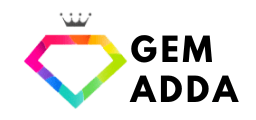RUBY
Rubies are corundum, a rock-forming mineral and crystalline form of aluminum oxide (Al2O3) with two aluminum atoms and three oxygen atoms in a densely packed hexagonal structure. Titanium, iron, chromium, and vanadium are commonly found in corundum. The presence of chrome during formation gives ruby a red hue. The higher the chromium content, the more intense the red color, while iron adds brown tones. The most prized shade is intense crimson, often called pigeon blood red.
Myanmar produces the majority of the highest-grade Manik. Its Burmese mine is quite famous worldwide among gemstone enthusiasts. Other countries include Thailand, Sri Lanka, Africa, India, and Vietnam.
Identification of Real Ruby
Nowadays, the demand for rubies is very high in the market, and people fail to recognize the difference between real and simulated. When people don’t know the difference, it becomes easy for a few sellers to sell duplicate gems for real gems. Here are some easy tests by which you can identify real ruby among its duplicates.
1. Get The First Idea
This is the first and quickest test for identifying real ruby stones. Professional gemologists and jewelers also take first indications on this basis. Mainly four things are seen in this:
A) Color: Red Spinel, Garnet, and Ruby get confused with each other due to their similar colors, but if the color is too dark, it may be garnet. Red Spinels is also lighter red with pinkish and orange hues. Other than this, its imitations are dull, less vibrant, and out of proper shade. The real ruby has vibrant red colors.
B) Facets: The facets of real ruby will be fine and smooth due to their good hardness, while the facets of fake ruby are not so sharp and smooth. Check properly if any scratch areas appear.
C) Gravity: Real ruby is heavy, and most of its simulants are lighter than that. So for this test, take the ruby stone in your hand and feel its density. If it is light, then it may be fake.
D) Pricing: Natural rubies are precious and costly. Synthetics are typically less expensive than genuines. So remember this while buying rubies.
2. Scratch Test
Ruby is among the hardest stones found on Earth. It is very hard to break them. Scratch it with a coin or any other hard surface, such as stone or hard metal. If you can do it, then it is certainly not a real one.
You can rub it harshly on a flat surface. If the ruby leaves any residue, then it is a fake ruby. Always remember that the real Ruby never leaves residue on rubbing or scratching.
Also read: Identification of Glass-Filled Ruby
3. Check fluorescence.
Natural rubies typically show weak to moderate red fluorescence under long-wave UV (ultraviolet) light. Some natural rubies from specific sources, such as Burmese rubies, may exhibit a stronger red fluorescence. Most synthetic rubies show no fluorescence under UV light.
4. Ruby Breath Test
The Ruby Breath Test is also known as the “fog test.” Since rubies are efficient heat conductors, this technique works best. Take a ruby in your hand and bring it close to your mouth by exhaling on it. If your ruby is real, it will evaporate within 2 seconds, mostly in a single second. If your ruby is fake, it will take 1 to 2 minutes, sometimes more than that.
5. Ruby Light Test
For the Ruby Light Test Get yourself into the dark room. Then take a sharp white light and keep it pointed towards the ruby. Observe the color that comes out of the ruby. It is real if there is a red flash; otherwise, it is not. This happens because it has a high iron content and is naturally derived.
Also read; Ruby stone benefits
6. Magnification
Identification of real Ruby is finally decided based on microscopic study. But for this, you need to look with a 10x lens. Hold the ruby at a 45-degree angle in the light. Make sure you can see through it. Crystals (calcite, dolomite, apatite, etc.), three-directional needles (rutile, boehmite, ilmenite, etc.), parallel polysynthetic twin lamellae, color zoning, angular growth zoning, fingerprints, fluid inclusion, zircon holo, etc. are some inclusions that are found only in natural rubies.



